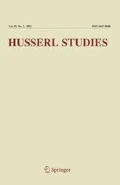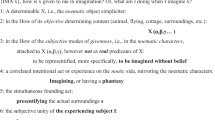Abstract
The problem of self-consciousness has been an essential one for philosophy since the onset of modernity. Both E. Tugendhat and the Heidelberg School represented by D. Henrich have reflected critically upon the traditional theory of self-consciousness, and both have revealed the circular dilemma of the “reflection-model” adopted by the traditional theory. In order to avoid the dilemma, they both proposed substitute formulas, each of which has its advantages and disadvantages. Husserl also paid particular attention to the traditional theory of self-consciousness in his phenomenology. Through the distinctions of “primal consciousness” and “reflection,” Husserl explored the core problem of the traditional theory of self-consciousness in two different dimensions. In his critique, Husserl clarified the founding relation between primal consciousness and reflection, and in contrast to Tugendhat’s semantic approach, he developed a new reflection-model of self-consciousness which effectively avoids the circular dilemma of the traditional theory and does not narrow the problem domain of that theory.
Similar content being viewed by others
Notes
For a detailed discussion of the dispute, see Zhang (2013, pp. 160–183).
„Fichtes ursprüngliche Einsicht“ (Henrich 1966, pp. 188–232). The article was a modified and substantially expanded version of Henrich’s lecture, “Fichtes „Ich“”, which was held at the Institute of France in the spring of 1966. The lecture draft was published in French in 1967, and was translated into German and published in Henrich (1982, pp. 57–82).
Henrich (1966, pp. 191f/1982, pp. 61f).
In addition to the two difficulties summarized by Henrich here, Fichte in fact identified an infinite regress: in order to have self-consciousness I must turn myself into an object, and so I cannot actually reach self-consciousness at all. The subject-I needs a further subject in order to cognize itself, and this will continue without end. See Frank (1986, p. 35) and (1991, p. 25). Contemporary discussions of self-consciousness often refer to this problem of infinite regress. See Zahavi (2005, pp. 17–29).
Hua XIX/1, A 332/B1 354; Hua XXIV, p. 247; Hua X, p. 118ff.,124ff. See also Ni (1998, pp. 77–99).
The so-called “dative I” here means the self-givenness of the stream of conscious experience to itself, the polarizing of consciousness toward ego that constitutes its first-person character. Ego means no more than an identification of the stream of consciousness, and the identification initially lies in the way of self-givenness of consciousness in the first person. It should be noted that the identification of the stream of consciousness here is different from the oneness (Einheit) of it. In Husserl, the latter is grounded in the double intentionality of the stream of consciousness (See Hua X, Sect. 38, 39).
See Hua I, p. 28, where Husserl also stressed that this three-sided structure forms the “inborn a priori” of the “concrete and transcendental Ego.” The disclosure of the “inborn a priori” fundamentally relies on a “self-examination” (Selbstbesinnung) that “is the most important methodological insight of phenomenology,” next to the phenomenological reduction.
Of course, this does not mean that the reflection-model of self-consciousness in Husserl’s phenomenology is merely pre-linguistic. It means, rather, that it is primarily concerned with the pre-linguistic dimension and only later with the dimension of language. This is the fundamental starting point of the philosophy of consciousness. My thanks to an anonymous reviewer for suggesting this point.
See Hua XXV, S. 80f. English translation in McCormick and Elliston 1982, p. 17.
Tugendhat claimed that all intentional consciousness is propositional, a point aimed at Brentano and Husserl. Brentano held that the second item in the intentional relation need not exist; for example, someone can fear, love, and desire N although N may not exist. But as Tugendhat suggested, “I can fear the devil even if he does not exist, but I cannot do so without believing that he exists. Hence, the point to which Brentano called attention—namely, that the object of an intentional mode of consciousness does not have to exist—is primarily a consequence of the fact that one can relate consciously to an object only insofar as one believes that it exists. Of course, the claim that an object exists is a proposition; and believing that it exists is a propositional consciousness” (Tugendhat 1979, p. 20/1989, p. 11). He went on to say that “If all intentional consciousness is either directly propositional or implies propositional consciousness, we can lay down the following universal principle: All intentional consciousness is propositional.” The formulation here reminds us of the description of the “psychic phenomenon” by Brentano (the psychic phenomenon is either the presentation itself, or is based on a presentation) and Husserl’s description of “intentional experience” (every intentional experience is either itself an objectified act, or is based on an objectified experience). See for example Hua XIX/1, A 458/B1 494. Here it is impossible to fully develop the discussion of Tugendhat's inference and its relation to Brentano and Husserl. For a related discussion, see Tugendhat (1976, pp. 98–103) and Rapic (2009).
Husserl began to take free variation by fantasy as the key step of eidetic reduction in the 1920s. See Hua XXVII, pp. 10ff. Hua IX, pp. 72–87; and Husserl (1985, pp. 410–420).
The difficulty of the traditional theory of self-consciousness is designated the “circular” dilemma by two other representatives of the Heidelberg School, U. Pothast and K. Cramer. See Pothast (1971, pp. 18–23) and Cramer (1974, pp. 537–603). For a more systematic analysis, see Mauersberg (2000, pp. 167–80).
See Düsing (2002, pp. 111–140). Originally published in Italian in 1992.
References
Cramer, K. (1974). Erlebnis. Thesen zu Hegels Theorie des Selbstbewußtseins mit Rücksicht auf die Aporien eines Grundbegriffs nach hegelscher Philosophie. In Stuttgarter Hegel-Tage 1970 (pp. 537–603). H.-G. Gadamer (Ed.). Bonn.
Düsing, K. (1992). Selbstbewußtseinsmodelle. Apperzeption und Zeitbewußtsein in Heideggers Auseinandersetzung mit Kant. In Zeiterfahrung und Personalität (pp. 89–122). Frankfurt am Main.
Düsing, K. (1993). Typen der Selbstbeziehung. Erörterungen im Ausgang von Heideggers Auseinandersetzung mit Kant. In Systeme im Denken der Gegenwart (pp. 107–122). H.-D. Klein (Ed.). Bonn.
Düsing, K. (1997). Selbstbewußtseinsmodelle. Moderne Kritiken und systematische Entwürfe zur konkreten Subjektivität. München.
Düsing, K. (2002). Gibt es einen Zirkel des Selbstbewußtseins? Ein Aufriß von paradigmatischen Positionen und Selbstbewußtseinsmodellen von Kant bis Heidegger. In Subjektivität und Freiheit. Untersuchungen zum Idealismus von Kant bis Hegel (pp. 111–140). Stuttgart-Bad Cannstatt.
Düsing, K. (2005). Fundamente der Ethik. Unzeitgemäße typologische und subjektivitätstheoretische Untersuchungen. Holzboog.
Düsing, K. (2009). Geschichte des Selbstbewusstseins und Selbstbewusstseinsmodelle. In Das Selbst und sein Anderes. Festschrift für Klaus Erich Kaehler (pp. 259–274). M. Pfeifer and S. Rapic (Eds.). München/Freiburg.
Frank, M. (1986). Die Unhintergehbarkeit von Individualität, Frankfurt am Main.
Frank, M. (1991). Selbstbewußtsein und Selbsterkenntnis. Essays zur analytischen Philosophie der Subjektivität. Stuttgart.
Gloy, K. (1990). Selbstbewußtsein als Prinzip des neuzeitlichen Selbstverständnisses. Seine Grundstruktur und seine Schwierigkeiten. Fichte-Studien, Bd. I, pp. 54–71.
Henrich, D. (1966). Fichtes ursprüngliche Einsicht. In Subjektivität und Metaphysik. Festschrift für Wolfgang Cramer (pp. 188–232). D. Henrich (Ed.). Frankfurt am Main. English translation: Fichte’s original insight. In Contemporary German philosophy Vol 1. Pennsylvania State U. Press, 1982.
Henrich, D. (1970). Selbstbewußtsein: Kritische Einleitung in eine Theorie. In Hermeneutik und Dialektik, Festschrift für H.-G. Gadamer (pp. 257–284). R. Bubner, K. Cramer, R. Wiehl (Eds.). Tübingen: J. C. B. Mohr. English translation: Self-consciousness: a critical introduction to a theory. Man and World 4/1, 1971.
Henrich, D. (1982). Fichtes ‚Ich.‘In Selbstverhältnisse. Gedanken und Auslegungen zu den Grundlagen der klassischen deutschen Philosophie (pp. 57–82). Stuttgart.
Henrich, D. (2003). Between Kant and Hegel. Lectures on German idealism. D. S. Pacini (Ed.). Massachusetts/London.
Hua I: Cartesianische Meditationen und Pariser Vorträge. S. Strasser (Ed.). Den Haag: Nijhoff, 1950; Cartesian meditations: An introduction to phenomenology. D. Cairns (Trans.). The Hague: Martinus Nijhoff, 1960.
Hua IV: Ideen zu einer reinen Phänomenologie und phänomenologischen Philosophie. Zweites Buch: Phänomenologische Untersuchungen zur Konstitution. M. Biemel (Ed.). Den Haag: Nijhoff, 1953; Ideas pertaining to a pure phenomenology and to a phenomenological philosophy 2. Studies in the phenomenology of constitution. R. Rojcewicz and A. Schuwer (Trans.). Dordrecht: Kluwer, 1989.
Hua VIII: Erste Philosophie (1923/24). Zweiter Teil: Kritische Ideengeschichte. R. Boehm (Ed.). Den Haag: Nijhoff, 1956.
Hua IX: Phänomenologische Psychologie. Vorlesungen Sommersemester 1925. W. Biemel (Ed.). Den Haag: Nijhoff, 1962.
Hua X: Zur Phänomenologie des inneren Zeitbewusstseins (1893–1917). R. Boehm (Ed.). Den Haag: Nijhoff, 1966; On the phenomenology of the consciousness of internal time (1893–1917). J. B. Brough (Trans). Dordrecht: Springer, 1992.
Hua XIX/1: Logische Untersuchungen. Zweiter Band: Untersuchungen zur Phänomenologie und Theorie der Erkenntnis. Erster Teil. U. Panzer (Ed.). Dordrecht: Kluwer, 1984.
Hua XIX/2: Logische Untersuchungen. Zweiter Band: Untersuchungen zur Phänomenologie und Theorie der Erkenntnis. Zweiter Teil. U. Panzer (Ed.). Dordrecht: Kluwer, 1984; Logical investigations, vols. 1 and 2. J. N. Findlay (Trans.), edited and revised by D. Moran. London: Routledge, 2001.
Hua XXIV: Einleitung in die Logik und Erkenntnistheorie. Vorlesungen 1906/07. U. Melle (Ed). Dordrecht: Kluwer, 1984; Introduction to logic and theory of knowledge. Lectures 1906/07. C. O. Hill (Trans.). Dordrecht: Springer, 2008.
Hua XXV: Aufsätze und Vorträge (1911–1921).Th. Nenon and H. R. Sepp (Eds.). Dordrecht: Kluwer, 1987.
Hua XXVII: Aufsätze und Vorträge (1922–1937). Th. Nenon and H. R. Sepp. Dordrecht: Kluwer, 1989.
Husserl, E. (1985). Erfahrung und Urteil. Untersuchung zur Genealogie der Logik, L. Landgrebe (Ed.). Hamburg: Meiner.
Kant, I. (2002). What real progress has metaphysics made in Germany since the time of Leibniz and Wolff? (1793/1804). In: Kant, Theoretical Philosophy after 1781, H. Allison and P. Heath (Eds.), P. Heath (Trans.). Cambridge: Cambridge University Press.
Kern, I. (1988). Selbstbewußtsein und Ich bei Husserl. In Husserl-Symposion Mainz 1988. G. Funke (Ed.). Stuttgart.
Mauersberg, B. (2000). Der lange Abschied von der Bewußtseinsphilosophie: Theorie der Subjektivität bei Habermas und Tugendhat nach dem Paradigmenwechsel zur Sprache. Frankfurt am Main/Berlin/Bern/Bruxelles/New York/Oxford/Wien.
McCormick, P. and Elliston, F. (Eds.). (1982). Husserl’s inaugural lecture at Freiburg im Breisgau (1917). In Husserl: Shorter Works. R. W. Jordan (Trans.). South Bend: University of Notre Dame Press.
Melle, U. (2005). Objektivierende und nicht-objektivierende Akte. In Edmund Husserl. Critical assessments of leading philosophers. Vol. III. R. Bernet, D. Welton and G. Zavota (Eds). London and New York: Routledge.
Ni, L.-K. (1998). Urbewusstsein und Reflexion bei Husserl. Husserl Studies, 15, 77–99.
Ni, L.-K. (2002). Self-consciousness and reflection. The basic problems of western philosophy since modern time (Zishi Yu Fansi: Jinxiandai Xifang Zhexue de Jiben Wenti). Beijing.
Ni, L.-K. (2010). The problem of the phenomenology of feeling in Husserl and Scheler. In Liangkang Ni, Zur Sache des Bewusstseins. Phänomenologie – Buddhismus – Konfuziansmus (pp. 163–178). Würzburg: Königshausen & Neumann.
Pothast, U. (1971). Über einige Fragen der Selbstbeziehung, Frankfurt am Main.
Rapic, S. (2009). Die versteckte Subjektivität in Tugendhats formaler Semantik. In Das Selbst und sein Anderes. Festschrift für Klaus Erich Kaehler (pp. 275–306). M. Pfeifer and S. Rapic (Eds.). München/Freiburg.
Tugendhat, E. (1967). Der Wahrheitsbegriff bei Husserl und Heidegger. Berlin: de Gruyter.
Tugendhat, E. (1976). Vorlesungen zur Einführung in die sprachanalytische Philosophie. Frankfurt a. M: Suhrkamp.
Tugendhat, E. (1979). Selbstbewußtsein und Selbstbestimmung. Sprachanalytische Interpretationen. Frankfurt a. M.: Suhrkamp; Self-Consciousness and self-determination. P. Stern (Trans.). Cambridge: The MIT Press, 1989.
Zahavi, D. (2005). Subjectivity and selfhood. Investigating the first-person perspective. Cambridge: The MIT Press.
Zhang, W. (2009). The foundation of phenomenological ethics: Intentional feelings. Frontiers of Philosophy in China, 4(1), 130–142.
Zhang, W. (2013). The material a priori and the becoming of person. A reconstruction of M. Scheler’s phenomenological material ethics of value (Zhiliao Xiantian yu Renge Shengcheng: Dui Shele Xianxiangxue de Zhiliao Jiazhi Lunlixue de Chonggou), Taipei: National Chengchi University Press.
Acknowledgments
This article is funded by the Youth Project of the National Social Science Fund of China (NSSFC) (Project No.: 12CZX047) and the Project supported by the Foundation for the Author of National Excellent Doctoral Dissertation of PR China (FANEDD) 2013 (Grant No. 201403).
Author information
Authors and Affiliations
Corresponding author
Rights and permissions
About this article
Cite this article
Zhang, W. How is a Phenomenological Reflection-Model of Self-Consciousness Possible? A Husserlian Response to E. Tugendhat’s Semantic Approach to Self-Consciousness. Husserl Stud 32, 47–66 (2016). https://doi.org/10.1007/s10743-015-9185-1
Published:
Issue Date:
DOI: https://doi.org/10.1007/s10743-015-9185-1




